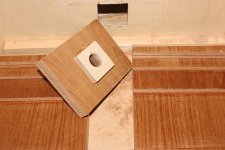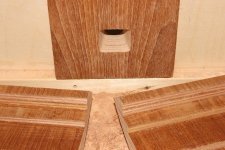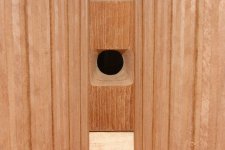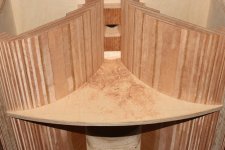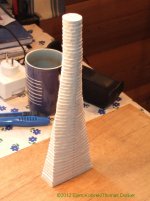something really big
I am going to use wood veneer built up in layers to create a plywood like structure. The material in the mouth and throat will be the more expensive veneer and subsequent layers cheaper. I will purchase sheets of veneer from Tape Ease. To shape, I'll just make a thick template and cut the stacked veneer blanks with a flush cut router bit. By stepping the veneer at the throat and mouth the thickness can be kept very thin. I am sure that if fiberglass resin is used as the glue between layers it will be strong. I'm still trying to find out more about the 1505 profile before starting.
I am going to use wood veneer built up in layers to create a plywood like structure. The material in the mouth and throat will be the more expensive veneer and subsequent layers cheaper. I will purchase sheets of veneer from Tape Ease. To shape, I'll just make a thick template and cut the stacked veneer blanks with a flush cut router bit. By stepping the veneer at the throat and mouth the thickness can be kept very thin. I am sure that if fiberglass resin is used as the glue between layers it will be strong. I'm still trying to find out more about the 1505 profile before starting.
I was thinking carbon fibre as a stiffener perhaps? Actually I was thinking of a complete multicell made of it.........mmmmmmmm shiny
Perhaps not 😉
I guess Hahnemuhle rag or some such photo paper could work as the interior of the cell.
Paper questions:
Would newspaper be adequate as a build up medium?
Thick paper in few layers or thin paper in many layers?
Perhaps not 😉
I guess Hahnemuhle rag or some such photo paper could work as the interior of the cell.
Paper questions:
Would newspaper be adequate as a build up medium?
Thick paper in few layers or thin paper in many layers?
IIRC, what I used as the paper base was Arches Cold Press Water Color paper, 300 lb. Thick and very stiff. Here it retails for about $2.50 a square foot. Not cheap. But I think you could go with a simple cardstock of similar weight for much less money. And cardstock comes in many colors, so the inside of the cells could be gray, black, white, blue or pink!
The Altec cells are exponential, I believe, so look into that profile.
The Altec cells are exponential, I believe, so look into that profile.
'The WayBack Machine' did a crawl over the DIYAudio page containing Petter Persson's multicells 24th October 2009. The thread was started 20th Jan that year.
Here is the link http://web.archive.org/web/20091024...i-way/136964-construction-multicell-horn.html
the server holding that info is down at the moment but should be up soon.
Here is the link http://web.archive.org/web/20091024...i-way/136964-construction-multicell-horn.html
the server holding that info is down at the moment but should be up soon.
Be careful with the wet mash. I can really soak into and destroy your base layer. Build a few cells and experiment is the best advice I can give you.
Or do as LFM is doing with thin wood strips of veneer.
Or do as LFM is doing with thin wood strips of veneer.
if they did not need to be super sturdy like pro horns that are made of metal.
Mine tend to bend at the mouth when I look at them the wrong way. Nice thing is you can easily bend them back.
At the smaller size of the 1005 or 803, the metal seems sturdy enough. Might be a good indicator not to go too large with paper!
how about adding balsa or carbon fibre (as light but stiffer in 1mm strip) strips along the cells walls?
Last edited:
Unless you go really big, like Cal's 1803, I doubt you'll have any trouble. Even the metal horns don't weigh much for their size. They are mostly air.
The tar filled versions, on the other hand, are beasts.
The tar filled versions, on the other hand, are beasts.
I know!!! Paper, who'd a thunk it?
now I need to read up on exponential curves. All the calcs I can find are for conical exponential horns, not just the curve.....
now I need to read up on exponential curves. All the calcs I can find are for conical exponential horns, not just the curve.....
I have one that Le /cleach came up with.
What are the individual horns tuned to? and do these sum into one larger horn with greater frequency extension? Cutoff is determined by horn length, among other things, correct.
What are the individual horns tuned to? and do these sum into one larger horn with greater frequency extension? Cutoff is determined by horn length, among other things, correct.
How about carbon and paper?
One should be able to find carbon tissue, looks like glass fibre finish tish' but its black!
Wall paper paste might work as a bonding agent, watery PVA definetly works.... I know this cos I've been moulding bits for model aircraft for the last 30 yrs (I make surfboards and auto-sport pieces now-a-days).
One can also laminate the tish' to 'Wall Lining Foam', use balsa wood strips on the throat and mouth edge, soak the balsa in 'superglue' to make it really hard, use 320grit wet/dry to feather the edges......
One should be able to find carbon tissue, looks like glass fibre finish tish' but its black!
Wall paper paste might work as a bonding agent, watery PVA definetly works.... I know this cos I've been moulding bits for model aircraft for the last 30 yrs (I make surfboards and auto-sport pieces now-a-days).
One can also laminate the tish' to 'Wall Lining Foam', use balsa wood strips on the throat and mouth edge, soak the balsa in 'superglue' to make it really hard, use 320grit wet/dry to feather the edges......
How you gonna make the throat? That seems the hardest part to me. You have to go from a square or rectangle where the cells join to round at the driver. Any ideas how to DIY that?
Yes, hadn't thought of that. It could be built up from wood thats shaped to fit.
Hmmm... I have another idea. I could make a few casts of the inside of the throat and send it to whoever wants. From positive that mold you could build up whatever you want around it.
Hmmm... I have another idea. I could make a few casts of the inside of the throat and send it to whoever wants. From positive that mold you could build up whatever you want around it.
For a longer manifold I would use a technique similar to the attached pic.
BUT instead of making the round from polystyrene, I would use a mandrel the size of the throat and slip rings over this, rings would be from ultra high density Pu modelling foam.
Does the spread sheet mentioned/attached to an earlier thread plot the manifold? being able to 'see' the shape is a great aid to making.
I know one thing, it's far easier to actually make it than describe it in words - I might have a go at making one just to see how it goes.
BUT instead of making the round from polystyrene, I would use a mandrel the size of the throat and slip rings over this, rings would be from ultra high density Pu modelling foam.
Does the spread sheet mentioned/attached to an earlier thread plot the manifold? being able to 'see' the shape is a great aid to making.
I know one thing, it's far easier to actually make it than describe it in words - I might have a go at making one just to see how it goes.
Attachments
Hmmm... I have another idea. I could make a few casts of the inside of the throat and send it to whoever wants. From positive that mold you could build up whatever you want around it.
Pano are any of your multicells for a 1.4" driver? If not could they just be extended as per the adapters you can buy?
I would definitely like to take you up on your offer
- Status
- Not open for further replies.
- Home
- Loudspeakers
- Multi-Way
- And Now For Something REALLY BIG
